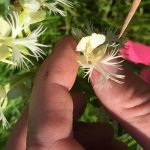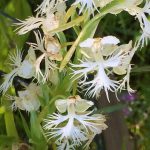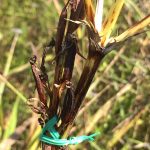Orchids have enduring cultural associations with perfection and beauty because of their petals’ marked symmetry. They fit in well at Fermilab, whose grounds feature balanced architecture and whose scientists look for mathematical symmetries in the subatomic universe.
In 2017 Fermilab Ecologist Ryan Campbell helped institute a plan to introduce a rare, native orchid species — commonly known as the eastern prairie fringed orchid — to aid in population recovery.
Draining wetlands and prairies in the Midwest over the past two centuries led to decimated populations of this specialized species. They are now listed as federally threatened and state-endangered by the U.S. Fish and Wildlife Service.
“Habitat loss is a really big factor in why this species is endangered and now considered federally threatened,” Campbell said.
Fermilab boasts some of the best restored prairie habitats in Illinois. Campbell recently planted the orchids strategically at seven different sites that matched the habitat they normally grow in, called wet prairie.
The U.S Fish and Wildlife Service granted Fermilab the uncommon opportunity to cultivate this species without affecting the laboratory’s science program. They provided the first batch of valuable seeds and will continue to supply seeds for another four years, increasing the number of flowers on the grounds and the number of sites where they’re planted.
Fermilab keeps track of many animals and plants in its habitats, helping them flourish by removing invasive species and introducing those they naturally live with, like the eastern prairie fringed orchid. This helps restore a habitat’s native species diversity.
“The philosophy at Fermilab is managing our habitats in a way that promotes all types of diversity, like genetic diversity and overall ecosystem diversity,” Campbell said.
After establishing an eastern prairie fringed orchid population on its grounds, Fermilab hopes to help restore its populations at other sites. A restoration team can cross-pollinate the flowers at Fermilab and provide seeds to other land management areas. Introducing seeds or pollen from elsewhere increases genetic diversity and benefits populations as a whole.
“If a population is established, we can use the pollen and seed produced to augment other Illinois eastern prairie fringed orchid populations,” said Cathy Pollack of the U.S. Fish and Wildlife Service who is the rangewide lead for the species and worked with Fermilab to develop the project.
Distribution of seeds to other areas means that someday the orchids could be a common sight in prairie habitats across Illinois, if one is careful enough to look.
“When you learn to appreciate the prairies in the Midwest, you can look down at just a square meter and see something that you would never have noticed before,” Campbell said.







